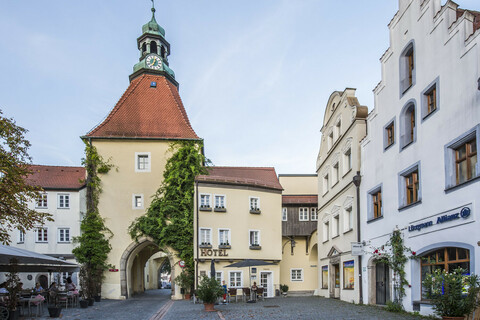Fortification by Charles IV, Holy Roman Emperor
A deed from the year 1347 passes on the instructions issued by Charles IV, Holy Roman Emperor, for the burgraves of Nuremberg to improve, build, and fortify the forts of Floß and Parkstein as well as the market town of Weiden. So it is then at the latest that Weiden in der Oberpfalz got its first wall, although it may be that town walls that already existed were built on and reinforced by the addition of towers.
The city walls today

If you look over the city’s stream from Kurt-Schumacher-Allee and the New Town Hall, you will recognize the southwestern corner of the old town fortifications with the main wall, outer bailey wall, corner bastion, and half tower. Unfortunately, it is not possible to discover when Weiden in der Oberpfalz was first fortified.
The Upper Gate

Back in history, there were particularly elaborate defense fortifications in the area of Upper Gate that were designed to look imposing as well. The gate system consisted of the gatehouse, the foregate in front with two mighty round bastions, and a stone bridge, which once led across the moat and was almost 16 m (52.5 ft) long.
The original core structure of the gatehouse probably dates back to the 13th century. It was torn down in 1911 and replaced with the Upper Gate that still exists today.
The Lower Gate

The Lower Gate, which formed part of the town fortifications in the 14th century, likewise fell victim to the flames in the devastating fire of Weiden in 1536, and was rebuilt.
It was after the Thirty Years’ War that it was given the look it has today with its attractive Baroque roof, as the upper half of the gate was shot to bits in 1635. In the old days, there was a keeper living in the gatehouse who had to herald the locking of the gate. Looking at the gate system from the Old Town side, it consisted of a gate with two mighty wooden doors, a portcullis, and a drawbridge onto what is now Schlörplatz which could span the moat.
The Lower Gate was badly damaged when the American troops moved in in 1945. In 1948, a pedestrian gate was then broken through the south pillar of the foregate, and the gate itself was repaired in 1950 even though there had been serious consideration given beforehand to tearing it down.




![[Translate to Englisch:] Stadtmauer Weiden](/fileadmin/_processed_/c/1/csm_Stadtmauer_Weiden_924d54872c.jpg)
 weiden.de
weiden.de
Data privacy Liability Legal notice